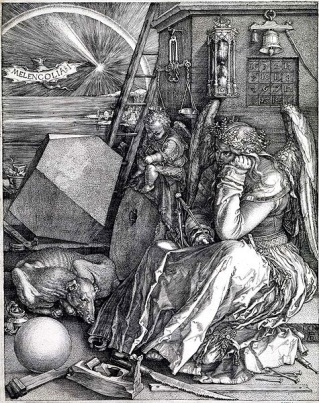Albrecht Dürer’s engraving Melencolia I contains an interesting magic square toward the top right corner.

Here’s a close-up of the magic square:

The square has the following properties:
- Every row, column, and diagonal sums to 34.
- The four squares in the center sum to 34.
- The four squares in the corners sum to 34.
- Each quadrant sums to 34.
- The year the engraving was made, 1514, appears in the bottom row.
I’d seen all this years ago, but this week I learned something else about this square.
Magic squares of different sizes were traditionally associated with planets in the solar system. … the 4 × 4 square in Melancolia is Jupiter’s … One suggestion for Dürer’s use of the square is that it reflected the mystical belief that Jupiter’s joyfulness could counteract the sense of melancholy that pervades the engraving.
From The Number Mysteries.
Regarding “Jupiter’s joyfulness,” here’s the etymology of jovial from Online Etymology Dictionary.
1580s, from Fr., from It. joviale, lit. “pertaining to Jupiter,” from L. Jovialis “of Jupiter,” from Jovius (used as gen. of Juppiter) “Jupiter,” Roman god of the sky. The meaning “good-humored, merry,” is from astrological belief that those born under the sign of the planet Jupiter are of such dispositions. In classical L., the compound Juppiter replaced Old L. Jovis as the god’s name. Related: Jovially.

